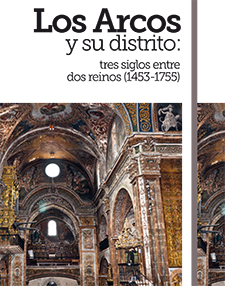LOS ARCOS AND ITS DISTRICT: THREE CENTURIES BETWEEN TWO KINGDOMS (1463-1753)
16 September 2016
Armañanzas: in the footsteps of its church, altarpieces and emblazoned houses
José Javier Azanza López. University of Navarra
Located in the western part of the merindad of Estella, the village of Armañanzas rises on a small mound between two hillsides, with the parish church of Santa María at the top of the hamlet. It is a church of medieval origin, period of which some vestiges are conserved, that was object of an extension in century XVI according to the Gothic Renaissance language. The architect was Juan de Landerráin (ca. 1535-1608), belonging to a dynasty of stonemasons from the Guipuzcoan town of Régil (Víctor Pastor Abaigar has studied in depth his career staff and professional career in Navarra in a article published in the magazine Príncipe de Viana), whose work is also documented in this period in towns such as Los Arcos, Legaria, Sansol, Viana, Larraga and Murillo el Fruto. Later, in 1765 Ventura Ciarra enlarged the church by opening two side chapels (the sacristy is attached to the one on the Epistle side) and a new narrower section at the base.
In final, the parish building has its starting point in the Age average, period of which some architectural vestiges are preserved, and acquires its physiognomy final in the Modern Age, with extensions in the Renaissance and the Baroque, episodes all of them collected in the Catalog Monumental of Navarre. The result is a rectangular nave of great width (the spatial sensation inside is of amplitude), divided in two square sections that concludes in a reduced straight chevet. Pillars with attached columns topped with capitals with balls of the Catholic Monarchs period act as support for the two sections of starred vaults with keystones decorated with the Virgin, busts of saints and symbols of Christ that cover the nave of the temple. A simple vault of terceletes with decorated keystones based on shields with crosses covers the main chapel, which is entered through a semicircular arch. On the other hand, the access to the interior of the temple takes place by a doorway of the XVI century of half point, formed by powerful voussoirs, protected by a portico of the XVII century formed by triple arcade on pillars, on top of which a body of windows is arranged. Surrounding the building there is a small wall that serves as a porch, in whose double access we find the reliefs of Saint Peter and Saint Paul (the latter accompanied by the date: YEAR 1681) and of the Virgin with the Child and Saint John the Baptist.
The parish of Armañanzas houses a set of altarpieces that allow a journey from the Renaissance to the Rococo, of undoubted interest from the point of view of the evolution of the masonry and formal language. The starting point is the main altarpiece, from the second third of the 16th century, which together with those of Genevilla, Lapoblación and El Busto (we could also add that of Piedramillera) is "the best group of altarpieces of our Plateresque Renaissance", in the words of José Esteban Uranga. position Its sculpture is attributed to the workshop of Andrés de Araoz (perhaps Juan Ruiz de Heredia or Juan Fernández de Vallejo?), while its assembly was almost certainly carried out by the assembler Martín Gumet, whose activity is documented at this time in Armañanzas.
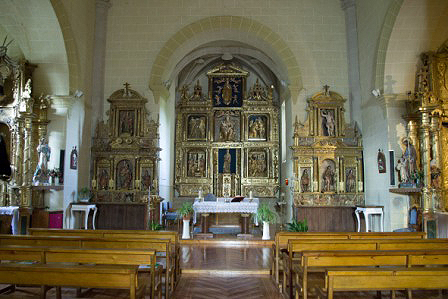
Armañanzas. Parish Church of Santa María
Inside
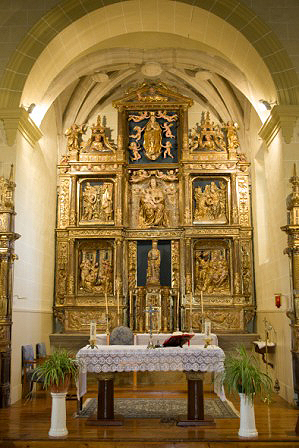
Armañanzas. Parish Church of Santa María
Main altarpiece
sample Its compositional clarity of design is organized in a bench, two bodies of three sections divided by columns with composite capitals and shafts with the lower third decorated and the rest fluted, and an attic of small columns that ends in a triangular pediment and is flanked by mixtilinear copetes with busts of prophets; Given the dominance of Marian themes in the altarpiece, perhaps they can be identified with Isaiah and Jeremiah, two of the prophets -together with Micah- that indirectly refer to Mary in those prophecies that predict the Incarnation of the Word of God. The different bodies of the altarpiece are separated by friezes ornamented with cherubs and grotesques with mythological motifs, and are framed by lateral bracelets with the reliefs of St. Anton and St. James and a fine candelieri decoration.
Detailing its iconography, on the bench are the reliefs of the Descent from the Cross and the Holy Burial, which give way in the bodies to a program of clear Marian significance: in the first the reliefs of the Birth of Jesus and adoration of the shepherds, and the Adoration of the Magi, in the second the Annunciation, the carving of the seated Virgin with the Child crowned by angels, and the Visitation, and in the attic the carving of the Assumption surrounded by angels on which is the bust of the Eternal Father. With its original polychrome with abundant use of gold, the sculpture offers the characteristic expressiveness of the second third of the 16th century, with the figures of serpentine hair, half-open mouth and long and wavy folds.
The tabernacle of the altarpiece has a trapezoidal plan, and originally consisted of two sections. The first, with the relief of Christ at the column flanked on the sides by St. Peter and St. Paul, has been preserved; the second, which featured the Pietà and two saints, has disappeared. Its place was taken by the carving of St. John the Baptist, from Shrine of Our Lady of Fair Love, originally from the 15th century but retouched in the Baroque period. In this location it was photographed in the Catalog Monumental de Navarra, although a later reform moved it to a side chapel, being replaced by a carving of the Virgin and Child, Romanesque from the second/third third of the 13th century, which Professor Fernández-Ladreda classifies within the group of sustaining virgins, which transmit a more humanized conception than their predecessors (images Throne of Wisdom), in that Mary ceases to be a mere seat of the child with her arms at right angles without touching the Child, and goes on to hold Jesus with her left arm, which puts her in relation to her son and insinuates her character as a mother.
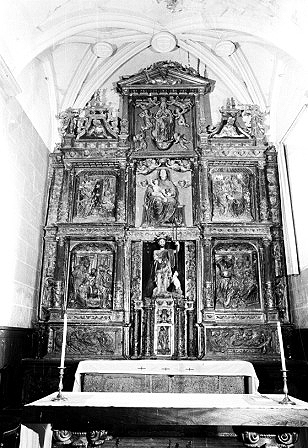
Armañanzas. Parish of Santa María.
Main altarpiece
(Photo: Catalog Monumental de Navarra)
Mary, seated and frontal, holds Jesus by the lower part with her left arm and raises her right arm to present the sphere; she wears a tunic tightened at the waist with a sash, a cloak and a veil. The child, who occupies the mother's left knee, wears a tunic and cloak, blesses with his right hand and holds an attribute with his left. In both cases, the clothing is characterised by an angular folding, which obeys formulas already seen in other Romanesque works, such as the images from subject Pamplona-Irache. A novel aspect with respect to previous carvings is the accentuation of the ascending sense achieved thanks to the slenderness of the figures, the elongated proportion of the faces and the vertical conception of the folding.
Moving on to the collateral altarpieces, the altarpieces of the Rosary and San Roque date from the beginning of the 17th century; the presence of Saint Teresa of Jesus, beatified in 1614 and canonised in 1622, serves as reference letter for a possible chronological dating around these dates. With minimal variations in their layout, both have a bench, a three-aisle body and an attic, with a joint based on columns with composite capitals and a wreathed shaft with a grooved lower third. Its rich iconography includes the main images of the Virgin of the Rosary, with a beautiful polychromy of the period based on plant motifs, and Saint Roque, with the pilgrim's staff in his left hand and the little dog at his feet, revealing the wound in his right leg. The sculpture, inspired by a late Romanesque style with Castilian influences of Gregorio Fernández, is characterised by the hard, broken folds of the vestments and the angular facial features, and is linked to the workshop of the Jiménez de Viana family.
At purpose of the altarpiece of San Roque, we would like to put forward some hypotheses, starting with its dedication. The presence on the central panel of the bench of the relief of the Martyrdom of Saint Sebastian (remember in this respect that the bench of the Rosary altarpiece contains the scene of the Virgin giving the rosary to Saint Dominic and is therefore connected with the titular image), the proportions of the carvings of Saint Roque and Saint Sebastian (in the attic) in relation to the spaces that house them (that of Saint Roque is too small for the niche, while the carving of Saint Sebastian is difficult to fit in the upper box and seems to have been cut), and the powerful anatomical study of the latter leads us to think of a possible original dedication of the altarpiece to Saint Sebastian, with a later change having occurred as a result of a "dance" of images; Thus, the central panel of the bench would coincide with the patron saint, as in the altarpiece of the Rosary.
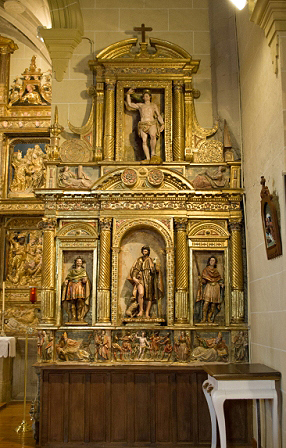
Armañanzas. Parish Church of Santa María
Altarpiece of San Roque
In addition, we should not overlook the fact that both Saint Sebastian and Saint Roque are advocates against plagues, which justifies their presence in the altarpiece (they also appear, for example, in the choir stalls of Los Arcos). And if we add to the above the inclusion in the same altarpiece of Saint Emeterius and Saint Celedonius (Calaguritanian martyr saints considered, according to tradition, to be healers of diseases related to bones and joints, such as rheumatism, arthrosis and arthritis, as Jesús González Celada has studied), Saint Barbara (protector against storms), Saint Casilda (advocate against the flow of blood and sterility in women) and Saint Margaret (advocate for women in pregnancy and childbirth), it seems clear that we are dealing with an altarpiece with a marked "thaumaturgical" significance. This purpose would be complemented in its Rosary collateral with the presence of Saint Lucia (advocate for the defence of sight), Saint Agnes (patron saint of young girls), Saint Agatha (patron saint of wet nurses and nursing mothers), Saint Blaise (protector against throat diseases) and Saint Catherine of Alexandria (patron saint of young marriageable and unmarried women). At final, two altarpieces that undoubtedly constituted an authentic "medical dispensary" for the rural population of 17th century Navarre.
Finally, the altarpieces of the Dolorosa and the Santo Cristo are in the Rococo style, executed by Antonio Izaguirre and Miguel López de Porras respectively. Both have a mixtilinear floor plan and rocaille decoration. The latter houses a Baroque Crucified Christ from the second half of the 17th century, with a dramatic expression and a gaze directed upwards; it is flanked by 18th century carvings of the Dolorosa and Saint John, characteristic Rococo figures with fine faces and voluminous draperies.
We now come to the field of civil architecture, where Armañanzas has a good issue of emblazoned houses. The so-called "Casa grande" (fig. 5) stands out among them, a masonry construction which, as Pilar Andueza Unanua points out, is in keeping with Baroque models from the transition between the 17th and 18th centuries, and can be found at contact with other examples in Los Arcos, Sansol and Añorbe. It is configured as a sober block of longitudinal development in which there is a succession of two high bodies and an attic crowned by a wooden eave with corbels richly decorated with foliage. On the lower floor there is a lintelled doorway with mouldings, flanked by pilasters topped by pyramids with balls, while on the main floor there are three balconies with period ironwork and two windows, all five framed by lintels with lugs and crowned with triangular pediments with dentils and a star on the tympanum. Inside the building, there is a magnificent staircase covered by a rectangular lowered dome with rectangular sashes between which there are lunettes and a lantern at the top, all of this on a moulded entablature with cut-out panels (fig. 6).
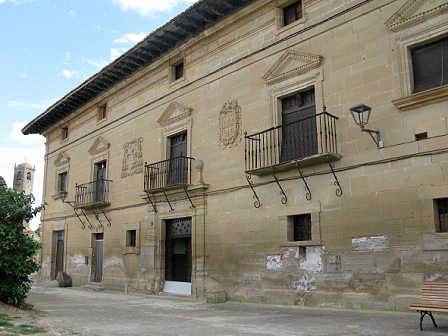
Armañanzas. Big House
Façade
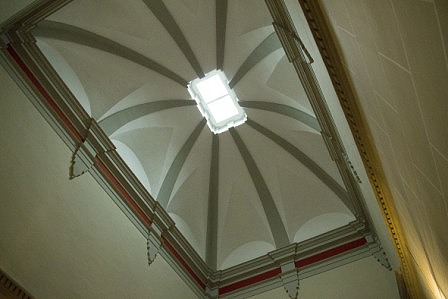
Armañanzas. Big House
Staircase
Between the balconies there are two coats of arms. The first of these is 17th century Baroque, on a cartouche of twisted leather, with a lower mask and double helmet and archiepiscopal helmet on ten tassels in four series. Its quartered field has in the first quarter a band with dragons' heads, accompanied on top by a star; in the second quarter, a bird accompanied on top by a crescent; and in the third and fourth quarters, two lions facing each other on cauldrons. This is (with some slight variations) the coat of arms of the Garín de Lazcano family, originally from the palace-house of the Lazcano family, in the town of the same name in Gipuzkoa. A family branch settled in the Navarrese towns of Armañanzas and Desojo, and later moved to the Álava town of Moreda de Álava. They possessed the title of nobility since 1555, obtained in the High Court of the Kingdom of Navarre, which allowed them to exercise the most important offices of the council.
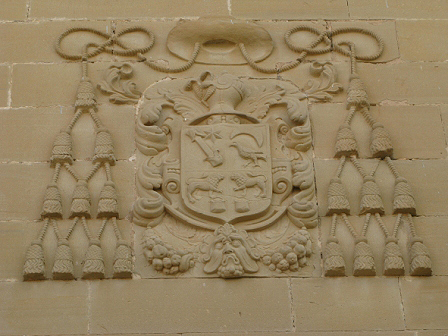
Armañanzas. Coat of arms of the Garín de Lazcano family.
The second coat of arms is rococo from the second half of the 18th century, with a border of rocaille and a double helmet and half lion. Its field has four cartouches divided by a cross: in the first quarter, two castles with their keep and a flag with a cross on each tower; in the second, two crescent moons with thirteen eight-pointed stars around each one; in the third, a lion rampant on a scree; and in the fourth, a yew tree to one of whose branches a bear is tied with a chain, leaving three fruits on the other side of the bush. The coat of arms is surrounded by a border of thirteen scallops and as many crosses of Santiago, around which there are thirteen flags with a average moon on each one of them. Above the coat of arms we can read the Latin legend: Ecce beatific(amus) eos qui sustinuerunt (Behold, we honour those who persevered), corresponding to the Epistle of the Apostle James 5, 11, while the lower part reads: "Arms of the Diez de Espinossa". This is the coat of arms of the lordship of Tejada, located in the Sierra de Cameros (La Rioja), granted in 844 by the King of Asturias and León Ramiro I in favour of his relative Sancho de Tejada, field master at the battle of Clavijo. This award, which was granted to Sancho de Tejada and his thirteen sons, entailed a series of privileges of nobility for them and their descendants, including the use of the coat of arms of the estate described in the Royal Decree of Enrique IV of Castile, given in Valladolid on 10 September 1460, and ratified by the Catholic Monarchs in 1491 and by King Juan Carlos in 1981. Of the thirteen sons of Sancho de Tejada, seven settled on the Tejada estate, five returned with their father to their lands of origin, and the youngest son constituted the Solar de Valdeosera, in the district of Torrecilla de Cameros (Logroño), with which it shares history and coat of arms, and had a line in the village of Armañanzas. From this line was Miguel Díez de Espinosa, a resident of Armañanzas, who, on his own behalf and together with his sons, presented before the courts of Navarre that his grandfather Juan Bautista Espinosa had obtained in the Royal Chancery of Valladolid a certificate of nobility as a descendant of the aforementioned solar house of Valdeosera, and that for this reason the same prerogatives should be kept for him and his sons, which was ordered(Heraldic and Genealogical Encyclopaedia, T. 27, pp. 107-108).

Armañanzas. Coat of arms of the Díez de Espinosa family.
Other stately houses in Armañanzas also have coats of arms, including a rococo coat of arms from the second half of the 18th century between lions holding lions and a helmet for a bell, flanked by children. In the field there is a checkerboard crescent and a checkerboard girdle. A lower legend identifies it as "Arms of García y Galdeano". In the Calle Mayor a house has an oval coat of arms from the end of the 17th century, on a cartouche of twisted leather and helmet for a bell, quartered: in the first quarter, five roulettes and a quarter crescent in point; in the second, a spread eagle; in the third, a castle; fourth, and in the fourth, a triple wall with three openings.
Finally, in a house in the street of source there is a Baroque coat of arms from the end of the 17th century with a border of foliage, between children and a helmet for a bell; in its quartered field, with a cross of Calatrava in the heart, there is a band with a dragon's head with average moon and star in chief and five panels and two cauldrons in point; two cauldrons and two fleurs-de-lis; five wild boars passing over four poles; and three bands between two cauldrons and a Maltese cross. The shield is surrounded by a border of blades between which is written: "Arms of Hugalde and Villamayor".
PROGRAM
Wednesday, 14th September
Between Navarre and Castile (1463-1753)
D. Roman Felones Morrás. Lecturer in History of Art at classroom de la Experiencia. Public University of Navarra
Tasting and savouring: the arts at the service of the senses in the parish church of Los Arcos
D. Ricardo Fernández Gracia. University of Navarra
Thursday, 15th September
Another jewel of the Renaissance in Navarre: the altarpiece of San Andres de El Busto
D. Pedro Luis Echeverría Goñi. University of the Basque Country
Stone and stonework at the service of the Church and the nobility in Sansol
Ms. Pilar Andueza Unanua. University of La Rioja
Friday, 16th September
Armañanzas: in the footsteps of its church, altarpieces and emblazoned houses
José Javier Azanza López. University of Navarra
The artistic heritage of Torres del Río: much more than the Santo Sepulcro (Holy Sepulchre)
María Josefa Tarifa Castilla. University of Zaragoza
Saturday, 17th September
visit Guided tour to Torres del Río, Armañanzas, Sansol, El Busto and Los Arcos.

